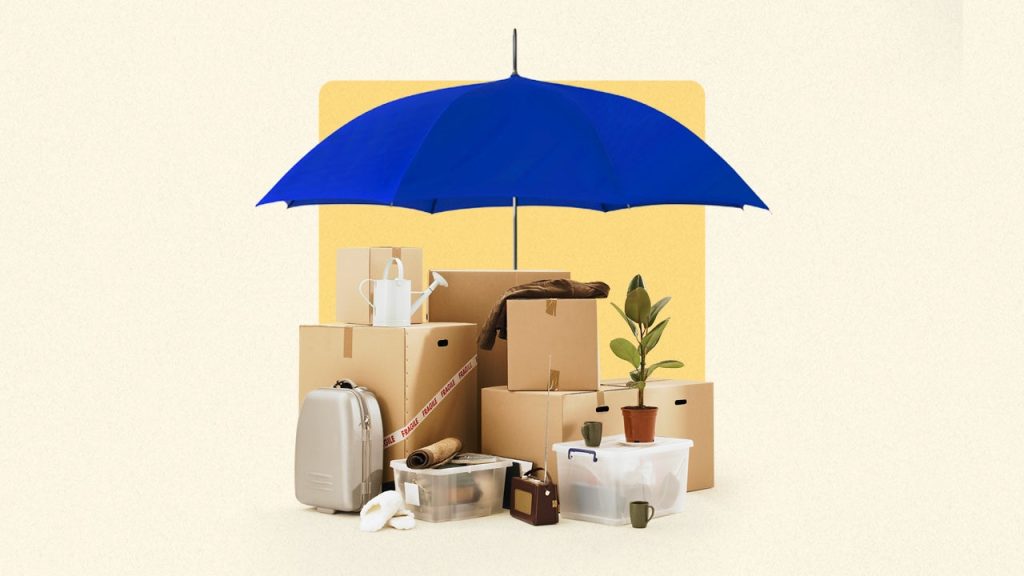Images by GettyImages; Illustration by Hunter Newton/Bankrate
Key takeaways
- Contents insurance, also called personal property insurance, provides coverage for your personal belongings up to your policy limits.
- Most home insurance policies include home contents insurance at 50-70 percent of the dwelling coverage amount that’s listed on your policy.
- Most insurance companies allow you to choose between insuring your items for actual cash value (ACV) or replacement cost value (RCV).
If you have homeowners insurance, your policy covers more than just the structure of your home. It typically also includes contents insurance, which provides coverage for your belongings if they are damaged by a covered peril — like a fire — up to your policy’s coverage limits. Knowing what exactly this coverage includes may help you decide how best to financially protect the contents of your home.
What is contents coverage?
Contents insurance, also referred to as personal property coverage, covers the contents of your home — up to your policy limits and barring exclusions. In short, your contents coverage applies to the vast majority of the belongings that you store in your house, such as furniture, clothing and appliances. Your contents insurance may also offer financial protection for things you store off-premises (up to a percentage of your policy limit) and damage to any of your guests’ belongings if they are impacted by a covered peril.
Contents are covered on a named perils basis in standard home insurance policies. This means that your personal belongings are only financially protected from perils specifically listed in your home insurance policy. These typically include perils such as fire, theft and windstorms, but do not include earthquakes, floods, neglect or mold unless you have coverage in place through an endorsement or separate policy.
What does home contents insurance cover?
Almost everything you own may be covered under your personal property coverage, but there are some limitations and exclusions. Here’s a general breakdown of what home contents coverage usually entails:
What is typically covered:
- Furniture
- Clothing
- Electronics, including TVs and computers
- Decor
- Books
- Sports equipment, including bikes
- Dishes
- Jewelry (up to a certain value)
- Art
- Appliances that are not built-in (e.g., blenders, toasters, mixers)
- Firearms
What is not typically covered:
- The full value of expensive items
- Vehicles and aircraft
- Installed features like flooring, furnaces, cabinets, etc. (if you own a home, dwelling insurance will step in here)
- Animals, including birds and fish
- Items covered by a separate insurance policy (e.g., jewelry that has its own policy)
- Belongings owned by any tenant or boarder
- Items that you lost or misplaced
How much contents insurance do I need?
The amount of contents insurance you need will depend on the items you own and which items, if any, require special endorsements. To help you determine how much contents insurance you need, a home inventory can be an excellent tool.
Most homeowners insurance policies include contents insurance with a coverage limit that is 50-70 percent of the policy’s dwelling coverage, according to the Insurance Information Institute (Triple I). So if you have $300,000 in dwelling coverage, your contents coverage would be between $150,000 and $210,000.
Other home policies, like condo insurance, may vary in their contents coverage, so it’s always important to read the fine print. Your carrier may have an automatic content coverage limit in your policy — or they could have a minimum or maximum amount you can choose from.
Actual cash value vs. replacement cost value
When insuring your home contents, most insurance companies allow you to choose between insuring your items for actual cash value (ACV) or replacement cost value (RCV). RCV coverage will pay to replace an item destroyed by a covered peril with a similar version at today’s prices. On the other hand, ACV coverage pays you for the depreciated value of the item. This is calculated by subtracting the item’s depreciation (determined at the time of the loss) from its current replacement cost.
RCV coverage is typically more expensive, but it might make sense if it would be a financial strain to replace your furniture with new versions after a total loss. On the other hand, if most of your furniture and electronics are fairly new or you have the money to replace items comfortably after a loss, ACV may be sufficient for you. Speaking with a licensed insurance agent may help you identify the best coverage option for you based on your belongings and the cost of coverage.
Valuable item sublimits
You will notice quite a few high-value items have been included in the list of what contents insurance covers. While home contents coverage usually will help pay to replace the item, almost all policies place sublimits on certain item types. For example, your policy might pay out up to $1,500 to replace stolen or damaged jewelry. Read your policy to identify any specific sublimits. If your contents insurance would not be sufficient to cover some of your more expensive belongings, you might explore specifically adding them to your insurance policy through a rider or endorsement (for an additional cost). Alternatively, you may be able to get a separate insurance policy for them.
Frequently asked questions
Why we ask for feedback
Your feedback helps us improve our content and services. It takes less than a minute to
complete.
Your responses are anonymous and will only be used for improving our website.
Help us improve our content
Read the full article here












